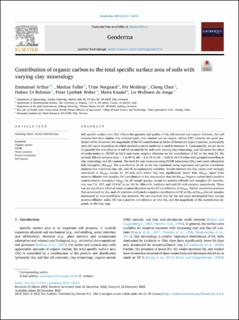| dc.description.abstract | Soil specific surface area (SA) reflects the quantity and quality of the soil mineral and organic fractions. For soil samples that have similar clay mineral types, clay content and or organic carbon (OC) contents are good predictors of SA. However, the magnitude of the OC contribution to SA for different soil types is unclear, particularly since SA varies depending on which method or probe molecule is used to measure it. Consequently, we set out to (i) quantify the contribution of soil OC to total SA for soils with varying clay mineralogy, and (ii) assess the effect of probe molecule (EGME or H2O) and water sorption direction on the contribution of OC to the total SA. We utilized 330 soil samples (clay = 1 to 89 %; silt = 2 to 78 %; OC = 0.03 to 34.9 %) that were grouped according to clay mineralogy and OC content. The total SA was measured using EGME adsorption (SAE) and water adsorption and desorption (SAH2O). The contribution of OC to SA was examined using regression and partial correlation analyses that combined clay, silt, and OC as explanatory variables. Results showed that SAE values were strongly correlated to SAH2O, except for OC-rich soils where SAE was significantly lower than SAH2O. Apart from montmorillonite-rich samples, OC contribution to SAE was smaller than for SAH2O. Organic carbon had a positive contribution to desorption SAH2O for all sample groups, except for montmorillonite-rich samples; OC contribution was 7.5, 10.7, and 13.9 m2/g per %C for illite-rich, kaolinite-rich and OC-rich samples, respectively. There was no significant effect of water sorption direction on the OC contribution to SAH2O. Partial correlation analyses that accounted for clay and silt contents confirmed a negative contribution of OC to SAE or SAH2O for soil samples dominated by montmorillonite clay minerals. We can conclude that for the soil types investigated here (except montmorillonitic soils), OC has a positive contribution to total SA, and the magnitude of the contribution depends on the clay type. | en_US |

